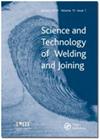In与高杂质Cu接头之间无空隙界面
IF 3.7
3区 材料科学
Q2 MATERIALS SCIENCE, MULTIDISCIPLINARY
Science and Technology of Welding and Joining
Pub Date : 2023-09-20
DOI:10.1080/13621718.2023.2259720
引用次数: 0
摘要
摘要对Cu膜中杂质对富锡焊点界面空穴形成的影响进行了广泛的研究。然而,很少对In焊点进行这方面的研究。本研究对Sn-3.0Ag-0.5Cu (SAC305)和高杂质In-solder/ Cu薄膜进行了150℃时效处理,分析了不同时效时间下的薄膜。一个亚稳态CuIn2相出现并转变为一个稳定的Cu11In9相。在固相时效过程中,SAC305/Cu界面出现了明显的空洞和裂纹。而In与Cu-CP之间存在无空洞界面。这主要是由于in /Cu和SAC305/Cu之间的扩散行为不同。揭示了上述现象的机理。关键词:电镀铜;沈友安感谢国家科学技术委员会112-2221-E-035-022-和111-2221-E-035-054-项目资助。陈志明感谢国家科学技术委员会110-2221-E-005-006-MY3项目。感谢国立阳明交通大学仪器资源中心(EM002800)对MOST 111-2731-M-A49-001项目的支持。国立清华大学仪器仪表中心项目EPMA000200 (111-2731-M-007-001)。披露声明作者未报告潜在的利益冲突。李佳怡:验证、形式分析、调查、数据策展。沈玉安:形式分析、调查、数据整理、验证、写作-原稿、写作-审稿、项目管理、资金获取。陈志明:概念化、方法论、验证、数据管理、写作-原稿、写作-评审与编辑、监督、可视化、项目管理、资金获取。这份手稿是全体作者共同完成的。所有作者都同意了手稿的最终定稿。数据可用性声明当前研究中使用和分析的数据集可根据通讯作者的合理要求提供。本工作由国家科学技术委员会资助:[批准号112-2221-E-035 -022-];国家科学技术委员会项目[批准号:110-2221-E-005 -006 -MY3];国家科学技术委员会资助项目[批准号111-2221-E-035-054-]。本文章由计算机程序翻译,如有差异,请以英文原文为准。
Void-free interface between In and high-impurity Cu joint
AbstractThe effect of impurities in the Cu film on the void formation at the interface of the Sn-rich solder joint has been extensively studied. However, this has rarely been studied for In solder joints. In this study, Sn-3.0Ag-0.5Cu (SAC305) and In-solder/ Cu films with high impurities were aged at 150 °C to analyze the films at various aging times. A metastable CuIn2 phase appeared and transformed into a stable Cu11In9 phase. Noticeable voids and cracks were observed at the SAC305/Cu interface during the solid-state aging. In contrast, there was a void-free interface between In and Cu-CP. This was primarily due to the difference in diffusion behaviour between In/Cu and SAC305/Cu. The mechanism of the above phenomenon was revealed.KEYWORDS: Electroplated Cu; In solderKirkendall effectimpurityaging AcknowledgementsYu-An Shen thanks the National Science and Technology Council under Project 112-2221-E-035-022- & 111-2221-E-035-054-. Chih-Ming Chen thanks the National Science and Technology Council under Project 110-2221-E-005-006-MY3. The support of Ultra HR SEM at National Yang Ming Chiao Tung University Instrument Resource Center (EM002800) under Project MOST 111-2731-M-A49-001 was appreciated. EPMA000200 of Instrumentation Center at National Tsing Hua University under Project Most 111-2731-M-007-001 is appreciated.Disclosure statementNo potential conflict of interest was reported by the author(s).Author contributionsJia-Yi Lee: Validation, Formal analysis, Investigation, Data Curation.Yu-An Shen: Formal analysis, Investigation, Data Curation, Validation, Writing – Original Draft, Writing – Review & Editing, Project administration, Funding acquisition.Chih-Ming Chen: Conceptualization, Methodology, Validation, Data Curation, Writing – Original Draft, Writing – Review & Editing, Supervision, Visualization, Project administration, Funding acquisition.The manuscript was written through contributions of all authors. All authors have given approval to the final version of the manuscript.Data availability statementThe datasets used and analyzed during the current study available from the corresponding author on reasonable request.Additional informationFundingThis work was supported by National Science and Technology Council: [Grant Number 112-2221-E-035 -022-]; National Science and Technology Council: [Grant Number Project 110-2221-E-005 -006 -MY3]; National Science and Technology Council: [Grant Number 111-2221-E-035-054-].
求助全文
通过发布文献求助,成功后即可免费获取论文全文。
去求助
来源期刊

Science and Technology of Welding and Joining
工程技术-材料科学:综合
CiteScore
6.10
自引率
12.10%
发文量
79
审稿时长
1.7 months
期刊介绍:
Science and Technology of Welding and Joining is an international peer-reviewed journal covering both the basic science and applied technology of welding and joining.
Its comprehensive scope encompasses all welding and joining techniques (brazing, soldering, mechanical joining, etc.) and aspects such as characterisation of heat sources, mathematical modelling of transport phenomena, weld pool solidification, phase transformations in weldments, microstructure-property relationships, welding processes, weld sensing, control and automation, neural network applications, and joining of advanced materials, including plastics and composites.
 求助内容:
求助内容: 应助结果提醒方式:
应助结果提醒方式:


